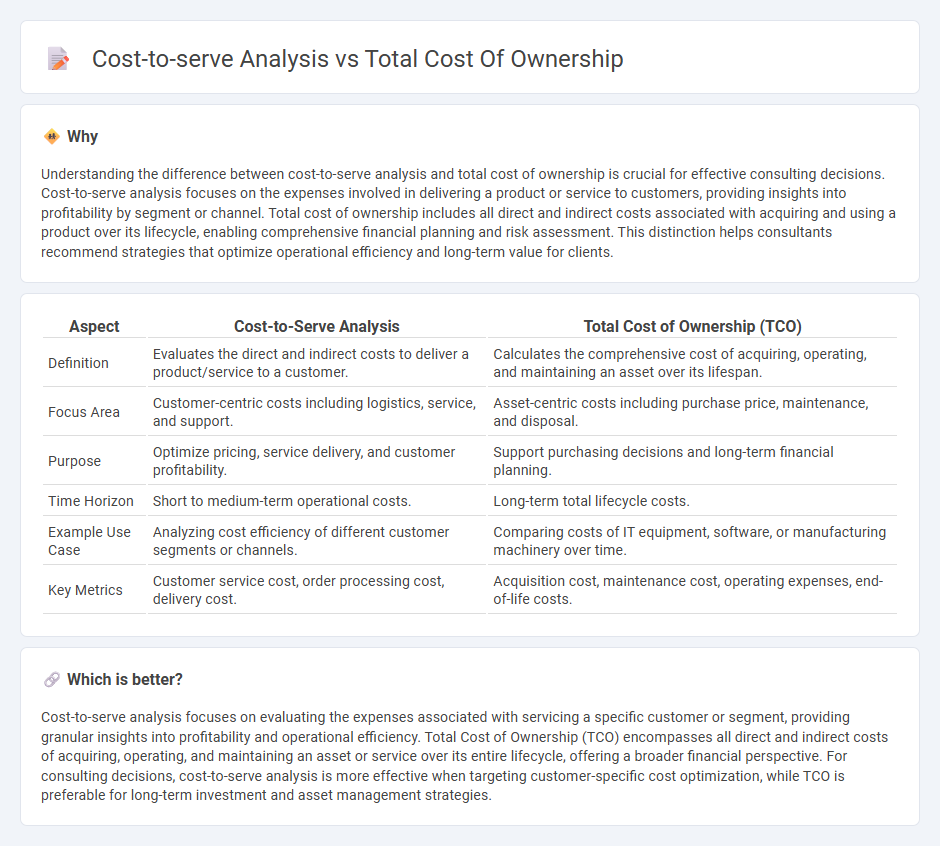
Cost-to-serve analysis evaluates the expenses associated with delivering a product or service to customers, focusing on activities such as order processing, logistics, and customer service. Total cost of ownership (TCO) measures the complete cost of acquiring and operating an asset over its lifecycle, including purchase price, maintenance, and disposal costs. Explore how integrating cost-to-serve analysis with TCO can optimize financial decision-making and improve operational efficiency.
Why it is important
Understanding the difference between cost-to-serve analysis and total cost of ownership is crucial for effective consulting decisions. Cost-to-serve analysis focuses on the expenses involved in delivering a product or service to customers, providing insights into profitability by segment or channel. Total cost of ownership includes all direct and indirect costs associated with acquiring and using a product over its lifecycle, enabling comprehensive financial planning and risk assessment. This distinction helps consultants recommend strategies that optimize operational efficiency and long-term value for clients.
Comparison Table
| Aspect | Cost-to-Serve Analysis | Total Cost of Ownership (TCO) |
|---|---|---|
| Definition | Evaluates the direct and indirect costs to deliver a product/service to a customer. | Calculates the comprehensive cost of acquiring, operating, and maintaining an asset over its lifespan. |
| Focus Area | Customer-centric costs including logistics, service, and support. | Asset-centric costs including purchase price, maintenance, and disposal. |
| Purpose | Optimize pricing, service delivery, and customer profitability. | Support purchasing decisions and long-term financial planning. |
| Time Horizon | Short to medium-term operational costs. | Long-term total lifecycle costs. |
| Example Use Case | Analyzing cost efficiency of different customer segments or channels. | Comparing costs of IT equipment, software, or manufacturing machinery over time. |
| Key Metrics | Customer service cost, order processing cost, delivery cost. | Acquisition cost, maintenance cost, operating expenses, end-of-life costs. |
Which is better?
Cost-to-serve analysis focuses on evaluating the expenses associated with servicing a specific customer or segment, providing granular insights into profitability and operational efficiency. Total Cost of Ownership (TCO) encompasses all direct and indirect costs of acquiring, operating, and maintaining an asset or service over its entire lifecycle, offering a broader financial perspective. For consulting decisions, cost-to-serve analysis is more effective when targeting customer-specific cost optimization, while TCO is preferable for long-term investment and asset management strategies.
Connection
Cost-to-serve analysis breaks down the expenses associated with delivering a product or service to customers, highlighting operational inefficiencies and resource allocation. Total cost of ownership (TCO) encompasses all direct and indirect costs over a product's lifecycle, including acquisition, maintenance, and disposal. Integrating cost-to-serve analysis with TCO provides a comprehensive view of financial impacts, enabling businesses to optimize pricing, supply chain strategies, and customer service investments.
Key Terms
Lifecycle Costs
Total cost of ownership (TCO) analysis captures the comprehensive expenses of acquiring, operating, and maintaining an asset throughout its entire lifecycle, including purchase price, maintenance, energy consumption, and disposal costs. Cost-to-serve analysis focuses on the expenses directly associated with delivering a product or service to customers, such as logistics, customer service, and order processing, highlighting operational efficiencies and profitability per customer segment. Exploring the nuances between TCO and cost-to-serve deepens understanding of lifecycle cost management and strategic decision-making; learn more about optimizing these frameworks.
Service Delivery Expenses
Service delivery expenses play a critical role in both Total Cost of Ownership (TCO) and Cost-to-Serve (CTS) analyses, impacting decision-making processes related to operational efficiency and profitability. While TCO encompasses all expenses over an asset's lifecycle, CTS zeroes in on the direct costs associated with delivering a particular product or service to a customer, including warehousing, transportation, and customer support. Explore detailed insights and methodologies to optimize service delivery expenses for enhanced financial performance.
Profitability Analysis
Total cost of ownership (TCO) quantifies the comprehensive expenses involved in acquiring, operating, and maintaining a product or service over its lifecycle, impacting long-term profitability. Cost-to-serve analysis breaks down the direct and indirect costs associated with servicing specific customers or channels, providing granular insights into profit margins and cost drivers. Explore detailed profitability analysis techniques to optimize costs and enhance business decision-making.
Source and External Links
What is total cost of ownership (TCO)? - TechTarget - Total cost of ownership (TCO) estimates all expenses tied to buying, deploying, managing, using, and retiring an asset across its entire lifecycle, offering a full cost perspective beyond the purchase price alone, especially relevant in IT and manufacturing contexts.
Cost of Car Ownership - 5-Year Cost Calculator | Edmunds.com - Edmunds defines TCO for vehicles as the purchase price plus operation costs over five years, including depreciation, financing, insurance, fuel, maintenance, and repairs, providing a comprehensive tool to compare car ownership costs.
Total Cost of Ownership Estimator - Reshoring Initiative - The TCO Estimator is a free online tool that calculates all relevant cost factors such as overhead, risks, and strategy, enabling companies to assess the real costs of sourcing decisions and compare alternatives beyond mere price.
 dowidth.com
dowidth.com